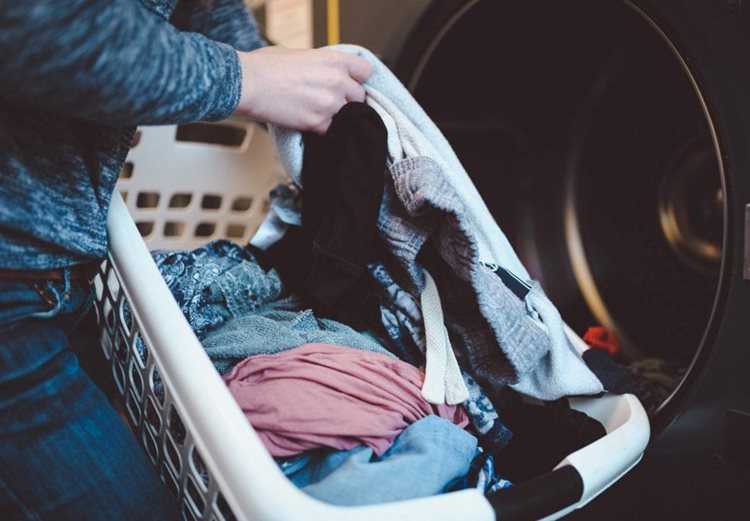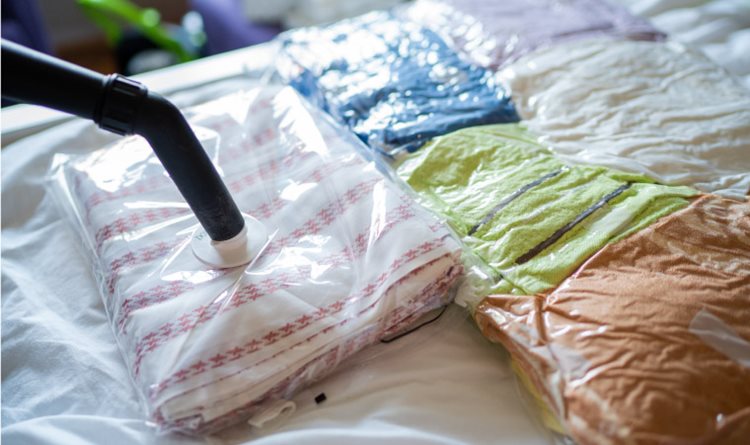
This Is The Best Way To Store Clothes Between Seasons
Home Organization Tips
If you live in a climate with distinct seasons, bulky winter jackets likely hang in your closet untouched during the hotter months, while swimsuits, summer dresses, and tank tops crowd your drawers in the winter. Even if you reside somewhere more temperate, seasonal vacation items — like ski jackets or beach cover-ups — go unworn, taking up precious wardrobe space for most of the year. Unless you have a roomy walk-in closet the size of a second bedroom, determining the best ways to store clothes by season is a highly effective (and essential) way to maintain an organized and functional space (not to mention it makes choosing your daily outfit a breeze!). So what’s the best way to store clothes by season? Here are 15 ideas that’ll help you start organizing your closet today.

One of the best ways to store clothes is to declutter before organizing.
1. Marie Kondo Your Clothes.
How do you store your clothes when you have too many? Tackle the latter before the former. Every major seasonal shift is the perfect time to review your wardrobe and purge what you no longer wear or want. Besides, according to organizing experts, it’s estimated that 80 percent of our clothing is only worn 20 percent of the time. It’s highly likely that you won’t even notice the pieces you clean out!
A good rule of thumb (when you’re starting a clothing purge) is to take anything you haven’t worn for a year and pass it on to another life. Donate what’s in good condition to charity, or (if your own clothing budget is tight) you can sell items online for cash or in local thrift stores for cash or credit. You can even take stained or torn items to be recycled (and qualify for discounts) at stores like H&M, The North Face, Levi’s, and Madewell.
While it’s always best to donate or sell unwanted clothing items, some things are in such poor shape — stubborn stains, moth holes, crumbling elastic — that nobody else would want them.
Once you’ve done your due diligence by thoroughly sorting out the things you’re ready to part with, you’ll be better prepared to organize what’s left and store your off-season clothes.
| Clothing Purge Hack: If you’re finding it especially difficult to decide what to part with, hang up all your “maybes” behind a distinct hanger in the back of your closet. Any time you wear a piece from that section, hang it back up in front of the hanger. After three months, whatever remains in the “maybe” section can be sold or donated. |
2. Organize Your Wardrobe by Season.
Now that you’ve slimmed down your wardrobe, it’s a lot easier to start storing clothing. So what are the best ways to store clothes? Think about what types of clothing you own and what you need them for, then group them together based on both season and activity. Pair all winter recreational clothes together, like ski jackets, heavy-duty down coats, mittens, and hats. For summer groupings, pair your sun hats, swimsuits, shorts, and sundresses together. While sorting, empty out pockets and check for items that need to be washed, dry-cleaned, or repaired.

Wash your clothes before storing them to prevent set-in stains and odor.
3. Do Laundry Before Storing Clothes.
Before storing clothes in plastic containers or boxes, make sure they’re all properly cleaned to avoid the spread of odors between items. Also, try to remove any stains before storing them, since the longer a stain is left untreated, the harder it is to get out. If you have clothing with stains that are just too stubborn, consider adding those pieces to the recycling pile.
4. Mend Any Damaged Clothing.
The last thing you want is to pull out a warm wool cardigan on a chilly day only to find a button missing. After organizing, you should have a pile of items that need repair — buttons, zippers, patches, etc. If you’re handy with a needle, you can handle the task yourself. If not, you can take these items to a local seamstress or tailor to fix them before storing them.
5. Perfect Your Folding Technique.
If you’re folding clothing before placing it inside containers, you’ll want to pay attention to how you’re folding it. While it may seem like a flat fold would work best for maximizing container space, you might have more luck with the army roll. Army rolling clothing involves folding an item in half lengthwise, then rolling it tightly from one end to the other, creating a compact cylindrical shape. This method not only cuts down on space, it helps minimize wrinkles and allows you to easily identify pieces when you need them later.

Storing clothes in plastic containers is great for stacking purposes.
6. Choose Containers Based on Contents and Location.
One of the most important tips for how to store clothing is figuring out the right storage container. For seasonal clothing storage, this depends on what you’re storing and where. Here are some of the most popular options for storing clothes:
Plastic Bins
Storing clothes in plastic containers is a practical choice because they are easy to handle, stack well, and keep moisture and bugs out (for more, see Step 9). While clear bins are great because it’s easy to see what’s inside, if the clothes are exposed to sunlight, it’s best to use dark-colored bins to avoid fading.
Cardboard Boxes
Since cardboard boxes can attract insects and offer no protection against moisture, they should only be used for storing clothes inside your home or indoor storage unit. Avoid using cardboard if you're storing clothes in a garage, unfinished basement, or attic. And clothing made from delicate or wool fabric should never be stored in cardboard boxes.
Fabric and Canvas Bins
In addition to plastic bins, fabric or canvas bins are another alternative favored by organization specialists because the material is breathable. Though more expensive, they make a good option for clothing made from delicate fabrics such as silk or cashmere. They also create an attractive choice for closet storage, primarily if you use stylish fabric boxes with clear windows, so you can easily see what’s tucked away inside.
| Tip To Avoid Dust: There are as many storage container options as there are stitches in your holiday sweater. When choosing a container for months-long seasonal clothing storage, avoid ones that have open tops, as these will invite dust — adding yet another step to your seasonal to-do list. If you have items that you prefer to hang (we’re looking at you, fancy dress), be sure to use a garment bag for the same reason. |
7. Pack Logically and Label Your Containers.
Pack clothes together by season and activity and label the containers. That way, you can easily pull out what you need when chillier weather hits or you’re heading out on a trip to the mountains — or even a mid-winter escape to the Caribbean. If you’re organizing your entire family’s wardrobe, one of the best ways to store clothes that aren’t in season is to consolidate everyone’s clothes into the same bins, since you’ll most likely need them all simultaneously. Place each person’s clothes in a smaller labeled bag, then store them in the same bin together.

The best way to store clothes like suits and gowns is to hang them.
8. Hang Things Up the Right Way.
As we mentioned earlier, some things are best left on the hanger. Don’t take this as your cue to simply rotate them to the back of your closet, though. You need to do a couple of things to make sure these pieces will be in tip-top shape when you pull them out in three months.
Use Breathable Garment Bags.
It’s tempting to leave your good suit in the plastic bag the dry cleaners gave you, but this isn’t the best way to store clothes because those bags aren’t meant for long-term storage. The dry-cleaning process (contrary to its name) actually uses liquid solvents. If the solvents haven’t fully dried, the plastic bag will trap that moisture and could lead to discoloration of your garment. Instead, use a garment bag made of fabric or another breathable material.
Avoid Wire Hangers.
Wire hangers are typically some of the cheapest options, and for good reason — the thin wire can stretch and distort fabric over time (especially knits). Hangers made of wood or with additional padding will better support your clothing and help prevent damage to the material.

Use lavender sachets instead of mothballs to keep unwanted intruders out.
9. Keep Bugs and Moisture Out.
Moisture and insects are the top enemies when you’re storing clothes. Avoid mold and mildew by ensuring all items are 100 percent dry before packing up. To be safe, toss in some moisture absorbers, which you can find online or at a local store. And keeping the bugs out starts with a thorough cleaning and inspection to ensure that your clothes are free of insect-attracting food residue. For wool or cashmere items, it’s essential to take extra measures using a moth-repellent. Instead of toxic, smelly mothballs, though, use cedar or lavender sachets. You can find plenty of options at retailers like Amazon.
| Tip for Storing Knits: It may be tempting to just hang your knit sweaters and cardigans in the back of your closet during the warm months of the year, but this can lead to the material becoming stretched and misshapen over time. Instead, neatly fold these pieces and store them flat in the container of your choice. |

Vacuum-sealed bags are perfect for storing clothes in tight spaces.
10. Save Space With Vacuum-Sealed Bags.
How do you store clothes when you don’t have enough closet space? If you’re limited on space or want to consolidate bulky clothes, use vacuum-sealable storage bags for off-season clothes storage. You can find them at your local storage and organization store or on Amazon.
Simply fold up your clothing items, place them in the bag, close the zipper, and then use the small pump attachment to suction out all the air. The result is a much more compact bag that you can easily slide under your bed, stack with others in a large bin, or store on an upper shelf. It’s incredibly convenient for bulky down jackets that can take up a lot of space.
11. But Don’t Vacuum-Seal Everything…
Just because we’re advocates for vacuum-sealed bags doesn’t mean they should be used for every article of your out-of-season wardrobe. Some pieces of clothing have natural fibers that the compression could damage. Keep everything in tip-top shape by avoiding putting these items in vacuum-sealed bags:- Winter coats and down jackets
- Gloves
- Items made of wool, cashmere, or silk
12. Find the Right Storage Spot.
The saying “location, location, location” doesn’t only apply to real estate; it’s also applicable for storing clothes. The best way to store clothes, especially if you’re looking for advice on how to store clothes long-term, is to keep them in a cool, dark, and dry place. Depending on your climate, the attic or garage may not be the best option because of extreme heat. If you’re using a basement, ensure it’s not prone to flooding or excessive moisture.
Since you’ll need to access these clothes when each season rolls around, they need to be in a spot that’s easy to get to. And whatever storage space you use, whether it’s in your attic or an indoor storage unit, don’t place your clothes behind piles of other stuff where they’ll be hard to find when you need them.
Here Are a Few Convenient Places To Store Your Off-Season Clothes:
- Store them in a guest room closet, high up on a shelf.
- Store them in your garage, attic, or basement (if they don't get too hot or humid) on a rack toward the front of your storage area.
- Another favorite spot for storage-challenged homes is under the bed. You can create more room by using bed risers, and then shop from a wide selection of storage containers made specifically for fitting under the bed, like these at Walmart or Amazon.
Finally, don’t forget to label everything! You don’t need a fancy labeling machine — just some masking tape with a permanent marker will do.
| Labeling Tip: Label your containers on the short and long side, so you can tell what they contain no matter how they’re stacked. |

When the temps shift, it’s time to reorganize your wardrobe.
13. Master the Seasonal Swap.
When spring or fall rolls around, and your off-season clothing suddenly becomes seasonally appropriate, it’s time to do the swap. Prepare your current wardrobe for storage (purge, organize, clean, and repair) so as you unpack this incoming season’s clothing, you can immediately pack and store last season’s wardrobe simultaneously. If you’re using a PODS storage container, it’s a simple matter of having the container delivered to your home, pulling out the stored items, and replacing them with the things you won’t need for the coming season. Don’t forget to freshen any lavender or cedar sachets and replace any moisture absorbers that were in storage.
14. Don’t Forget the Accessories.
We’ve discussed how to store clothing, but what about the smaller accessories? You’ve put away larger pieces in containers, but how do you store clothing items like toboggans, scarves, gloves, and the like? If you have room over a door or inside a closet, a hanging organizer is great for rolling up smaller items and keeping them all together. This could also work for summer pieces, like bathing suits, coverups, goggles, and sun hats.
15. Rethink Your Furniture.
If closets and containers just aren’t doing the job, you may be tempted to purchase a trunk or chest instead. Well, drop those keys and put down the credit card. You may be able to repurpose your existing furniture for a more practical solution. Whether adding under-the-bed trundles or retrofitting bookshelves with baskets, bins, or pull-out drawers, you can soon have a stylish and convenient place to keep seasonal items out of the way but not out of site.Seasonal Clothing Storage FAQs
Q: What is the best long-term storage for clothes?
A: If you need to store clothing for longer than a season, consider renting a PODS storage container. PODS can deliver it right to your driveway, where you can load it at your own pace (a great option for the initial “purge”). When you’re all loaded, PODS will pick it up and take it to a secure PODS Storage Center until you’re ready for it. This is especially useful if you have other seasonal storage needs (winter or summer sports gear, gardening or de-icing tools, equipment, supplies, etc.). Moving these things out of your house and into a PODS Storage Center frees up extra space in your home and garage for things you’ll actually be using during the current season.
Q: Is it better to store clothes in plastic or fabric? Also, is it better to store clothes in bags or boxes?
A: While storing clothes in plastic or fabric containers is acceptable, fabric is typically the more popular choice because the material is breathable, meaning it prevents odors and mildew while still shielding from dust and debris. However, if the clothing is in a damp or humid environment (like an attic), plastic will offer better protection than fabric. As for the bags vs. boxes debate, while we’d choose another type of container for long-term storage, boxes do provide more support than bags, which can leave clothing crumpled. Boxes also give you stacking ability.
Q: How do you store clothes so they don’t smell long-term?
A: You can do several things to avoid your clothes developing unwanted odors in storage.
- Clean and thoroughly dry your clothing and the storage container before packing things away.
- Pack a moisture absorber with your clothing and make sure your storage container is properly sealed to keep moisture out.
- Pack cedar or lavender sachets (or even dryer sheets) with your clothing to impart a pleasant smell during storage.
- Store containers in a cool, dark, and dry space.
Heather Magness is a member of the PODS Blog creative team. When she’s not formatting images and blog layouts, you can find her writing a song, watching a movie, or enjoying the great outdoors.
Related Articles
Comments
Leave a Comment
Your email address will not be published. Required fields are marked *
